
|
Astronomy Picture Of the Day (APOD)
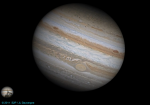 Jupiter Rotation Movie from Pic du Midi
Jupiter Rotation Movie from Pic du Midi
6.12.2011
Observe the graceful twirl of the Solar System's largest planet. Many interesting features of Jupiter's enigmatic atmosphere, including dark bands and light zones, can be followed in detail. A careful inspection will reveal that central clouds rotate slightly faster than clouds toward the poles.
 A Memorable Aurora Over Norway
A Memorable Aurora Over Norway
5.12.2011
It was one of the most memorable auroras of the season. There was green light, red light, and sometimes a mixture of the two. There were multiple rays, distinct curtains, and even an auroral corona. It took up so much of the sky.
 Light Echoes from V838 Mon
Light Echoes from V838 Mon
4.12.2011
For reasons unknown, star V838 Mon's outer surface suddenly greatly expanded with the result that it became the brightest star in the entire Milky Way Galaxy in January 2002. Then, just as suddenly, it faded. A stellar flash like this has never been seen before.
 As Above, So Below
As Above, So Below
3.12.2011
A single, long exposure captured these star trails above a remarkably colorful sea of clouds. As seen from Medvednica mountain, the surrounding peaks and lights illuminating the clouds from below are north of Zagreb, Croatia.
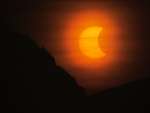 Solar Eclipse over Antarctica
Solar Eclipse over Antarctica
2.12.2011
Last Friday, the fourth and final partial solar eclipse of 2011 was only visible from high latitudes in the southern hemisphere. If you missed it, check out this dramatic picture of the geocentric celestial event from a very high southern latitude on the continent of Antarctica.
 Young Moon Meets Evening Star
Young Moon Meets Evening Star
1.12.2011
Now appearing as planet Earth's evening star, brilliant Venus shines in western skies at twilight. Standing above a rugged horizon and warm sunset colors, the twilight's celestial beacon was joined last Saturday by a Moon 35 hours young in this gorgeous skyscape.
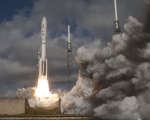 Curiosity Rover Lifts Off for Mars
Curiosity Rover Lifts Off for Mars
30.11.2011
Next stop: Mars. This past weekend the Mars Science Laboratory carrying the Curiosity Rover blasted off for the red planet atop an Atlas V rocket from Cape Canaveral, Florida, USA, as pictured above.
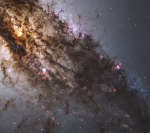 Across the Center of Centaurus A
Across the Center of Centaurus A
29.11.2011
A fantastic jumble of young blue star clusters, gigantic glowing gas clouds, and imposing dark dust lanes surrounds the central region of the active galaxy Centaurus A. This image from the Hubble Space Telescope has been processed to present a natural color picture of this cosmic maelstrom.
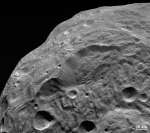 A Landslide on Asteroid Vesta
A Landslide on Asteroid Vesta
28.11.2011
Asteroid Vesta is home to some of the most impressive cliffs in the Solar System. Pictured above near the image center is a very deep cliff running about 20 kilometers from top to bottom. The image was taken by the robotic Dawn spacecraft that began orbiting the 500-kilometer space rock earlier this year.
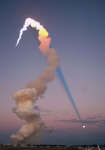 Shuttle Plume Shadow Points to the Moon
Shuttle Plume Shadow Points to the Moon
27.11.2011
Why would the shadow of a space shuttle launch plume point toward the Moon? In early 2001 during a launch of Atlantis, the Sun, Earth, Moon, and rocket were all properly aligned for this photogenic coincidence.
|
January February March April May June July August September October November December |
|||||||||||||||||||||||||||||||||||||||||||||||||